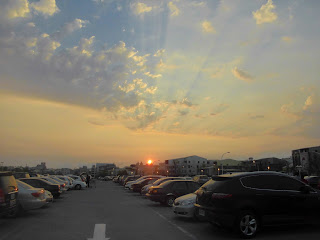旗津灯台を出て、もう一回フェリーに乗って湾の向こうにある元英国領事館に行ってみた。清朝時代、高雄(当時は「打狗」)の港は外国の貿易に開放された。そのため、イギリスはここにも領事館を建てることにした。日本時代に入っても、一時的に領事館として使用し続けたが、1910年頃に日本政府がこの敷地の領土権を主張して、譲ってもらった。
After leaving Cijin Lighthouse, I took the ferry back across the bay and then went to check out the former British Consulate at Takow. Takow (or Takao if you use the Japanese-derived spelling) is the old name for Kaohsiung that was in use up until the Japanese government left Taiwan and the RoC government took over. The consulate was originally built because Takow was one of the ports opened to foreign trade during the Qing Dynasty rule of the island. The building was used as a British consulate even after Taiwan was ceded to Japan in 1895, and it wasn't until 1910 that the Japanese took the building from the British and converted it to another use.
我離開旗津燈塔之後就去打狗英國領事館參觀。因為清朝時代打狗是一個為了外貿開放的海港所以英國在這裡建造兩棟建築。
途中でこの廟を見た。最初は屋根の上の鳩が飾り物かと思った。
On the way there, I passed by this temple.
路途我看到這座廟。首先沒注意到上面的鳥不是裝飾。
I did a double-take upon realizing that the bird motif on the top was an actual bird.
この建物は領事館の住居地。丘の上にあって、バルコニーがたくさんあるので、天気の暑さについて文句を言いながらここで座ってジントニックを飲んでいるイギリス官人の姿が微かに見える気がする。
And here's the former consulate residence. It's a very handsome building with lots of shaded verandas where one can imagine some empire-building dandies drinking their gin and tonics when the weather was too hot to work (just about all year round in Kaohsiung).
這棟是領館的居所。很典型的紅磚建築物。我看這棟就想到以前被派到熱帶的英國領館,認為他們應該在陽台坐著喝琴酒抱怨天氣這麼熱。
向こうに旗津灯台が見える。
We can see Cijin Lighthouse clearly across the way.
對面旗津燈塔
週末で、天気がよかったせいか、中国のグループツアーがめっちゃ多かった。以前訪れた時より多い気がした。相変わらず公のマナーが悪いので、細い山道を歩いていた時はしょっちゅうぶつかられた。
I
did visit on a weekend when the weather was nice, so it's to be expected that the place would be a little crowded, but unfortunately this place seems to have become even more of a destination for busloads of Chinese tourists than it was last time I was here a couple years ago. (Or maybe my timing was just bad.) Since there are lots of thin, hilly paths in the area here, I had many opportunities to go mano a mano with middle aged Chinese women who, despite having lived many decades already, have never been introduced to the concept of "staying to the right side of the road/walkway".
跟以前比起來我感覺到這次中國遊客增加了。這次天氣很好,也是週末,有可能只是我運氣不好,但是真的非常多了。
細い山道と言えば、住居の裏にこの小道があった。以前はなかったので、気になって降りてみた。
One of the above-mentioned hilly paths was this one in back of the main consulate building. This wasn't here last time I came, so I walked down to see what there was below.
我覺得這條山路上次還沒開,下去看看,,,
ガジュマル木以外、、、
There was a gnarly tree...
好酷的榕樹
、、、こんなのもあった!ちょっと吃驚した。
ロバートスウィンホー
...an imperialist oppressor and naturalist, frozen in time....
(
Robert Swinhoe)
Robert Swinhoe的塑像。栩栩如生我嚇了一跳。
下に新しい建物が開放された!港に近いから、領事館はここをオフィスにした。当時は主な仕事がイギリスの貿易を推薦することだったのだ。
...and a whole new building below! They must have opened this sometime in the last 2 years. According to the absolutely gorgeous English-language pamphlet that they provide (also new for me on this visit) this building was the actual consulate office. Since it's at the bottom of the hill, it's closer to the actual port where ships come in, and the primary business of the consulate was helping British trade interests in Formosa, so this was an important factor. (Also, comedy note, the beautiful pamphlet was, they told me, only available in English, and not even in Chinese.)
限制我的知識,這裡是最近(兩年以內)開的。上次我沒看。這棟其實是領事館的辦公室。因為離海港比較近所以辦公室在邱下。當時領事館主要的工作是推廣英國的在台貿易所以靠近海港的事件很重要。
正直言ったら、新しい建物はがっかりした。展示物がそんなに多くなくて、だいたいイギリスのお茶とか販売している店になっていた。上の方の領事館住居の方が見る価値がある。
To be honest though, the newly restored/rebuilt consular office was a big disappointment. While it was pretty from the outside, it was lacking much in the way of museum material inside. Instead, the inside was mostly just a big shop selling British things like tea, and cups with which to drink tea. Most of the historical exhibits are up at the residence on top of the hill, so I'm not sure it was even worth it to come down here.
跟邱上的居所比起來,辦公室的展示物比較少,空間大部分被販售關於英國產品的商店佔領的。居所比較有趣。
住居に戻ってきた。
Here we are back up at the residence.
回居所來
高雄湾を見下ろす景色がすごい。
The consular officials would have seen this view too, though with more trees and rice fields and fewer buildings.
站在打狗觀看高雄
窓を停めるやつ
A lock for the shutters
為了把窗開住的東西。
パパイアの木と日の入り
Papaya trees in the sunset
落日和木瓜
下の海の方に行って、途中でヤモリを見かけた。台湾では別に珍しくないけど。
After leaving, I headed down to the water to check out Cijin lighthouse in the dark. I saw this gecko on the way. Not a rare occurrence, mind you, but I think they're cute, so I like to take photos of them.
我為了看夜晚的燈塔下海邊去。路途發現壁虎。
写真が微妙だけど、夜の灯台はこういう感じだ。
My camera's not very good at night photos, so this is all I got.
旗津燈塔。我的相機拍夜晚照片不適合。
またね!
Until next time!
待會見!









































































